Fire, an essential element for survival, warmth, and cooking, often becomes a challenge to create in the absence of matches or lighters. This challenge, however, sparks creativity and ingenuity, leading to the exploration of alternative methods for igniting a flame. These techniques, rooted in both ancient wisdom and modern science, offer a fascinating look into human resourcefulness. Understanding and mastering these methods not only prepares one for unexpected situations but also deepens the connection with the natural world. The following sections delve into various matchless fire-starting techniques, each with its unique approach and required materials.
Contents
Steel Wool And Battery
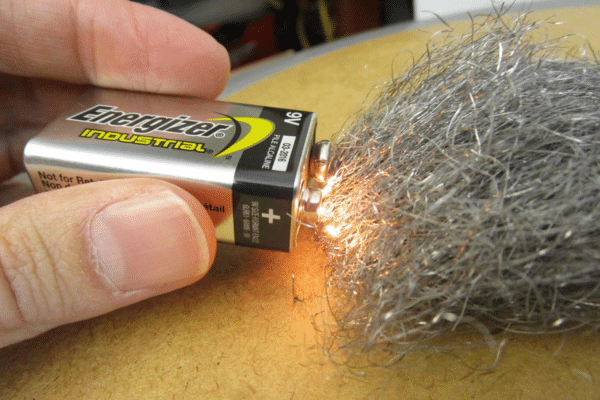
Fine steel wool and a battery can conjure fire through a simple yet fascinating chemical and physical reaction. When the metal filaments of the steel wool come into contact with both terminals of a battery, electrical current flows through the wool’s fine strands. This current encounters resistance in the thin metal, generating heat. Because of steel wool’s low ignition point, this heat is sufficient to ignite the material. The resulting sparks can then be transferred to a prepared tinder nest, catching the flame and starting a fire.
Safety and preparation are paramount when using this method. A 9-volt battery is ideal due to its compact size and the proximity of its terminals, but other battery types can also work with some adjustments. It’s crucial to ensure that the steel wool is fine enough to ignite easily and that the chosen tinder can catch the sparks. Users should be wary of the risk of battery leakage or explosion if it’s kept in contact with the steel wool for too long, emphasizing the importance of having everything prepared beforehand and separating the materials immediately after ignition.
Magnifying Glass
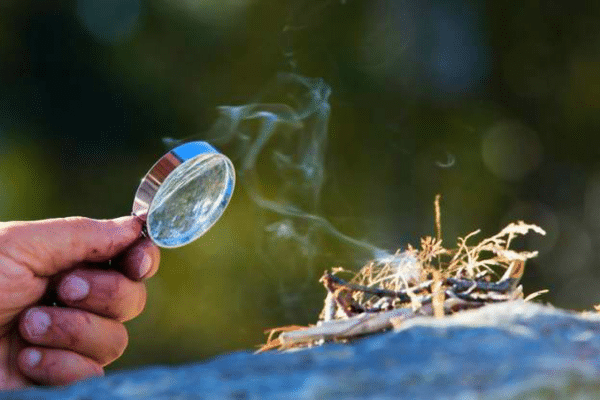
Harnessing the power of the sun, a magnifying glass can be transformed into a tool for fire starting. This method relies on focusing sunlight through the lens onto a single point on a piece of tinder, concentrating the light’s energy to produce heat. The intense focus and resulting heat at this focal point are enough to ignite the tinder. The success of this method is highly dependent on weather conditions; a clear, sunny day is crucial for generating a flame. The magnifying glass serves as a bridge between the sun’s vast power and the human need for fire.
For those without a traditional magnifying glass, creativity can find a substitute in other lenses, such as those from cameras or eyeglasses. The key lies in the ability of the lens to focus sunlight sharply. Experimentation with angles and distances may be necessary to find the optimal setup for ignition. This method not only demonstrates the ingenuity of using available resources but also the importance of patience. Achieving the precise focal point for the sun’s rays to ignite the tinder encapsulates a moment of triumph over nature’s challenges.
Flint And Steel
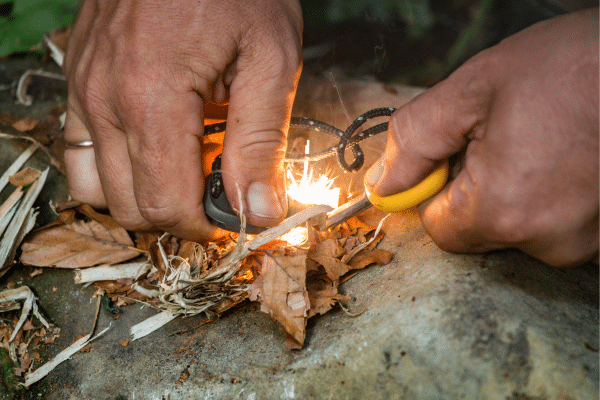
The flint and steel method is a time-honored technique that predates modern fire-starting tools. Striking a piece of flint against steel generates sparks due to the hard, sharp edge of the flint shaving off small particles of the steel. These particles, heated by the friction and the impact’s force, ignite when they come into contact with air. The sparks, though brief, are hot enough to light a carefully prepared bundle of tinder. This method’s effectiveness lies in the materials’ simplicity and the skill of the user in generating and capturing the sparks.
Mastering the flint and steel method requires practice and an understanding of the materials. The choice of tinder is critical, with dry, fluffy materials such as char cloth being particularly effective at catching the sparks. The technique of striking the flint against the steel also plays a significant role in success, with the angle of impact and the force applied influencing the quantity and quality of sparks produced. This method connects users with ancient fire-starting traditions, offering a sense of continuity with the past and a satisfying, direct interaction with the basic elements of nature.
Fire Plow
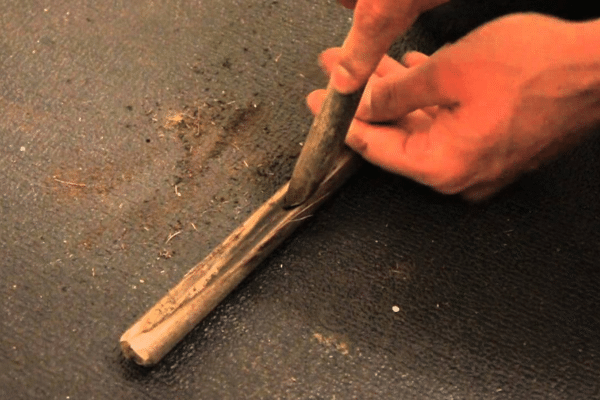
The fire plow method merges simplicity with the raw power of human effort to create fire. It involves the use of two pieces of wood, where one is rubbed vigorously against the other to generate enough friction and heat to produce embers. The base or the plow board is usually a flat piece of softer wood, and the plow or the rubbing stick is a harder, sturdy stick. The motion mimics plowing a field, with the stick being pushed back and forth along a groove in the baseboard. This action gradually builds up enough heat to create glowing embers that can be nurtured into flame with the addition of tinder.
Selecting the right materials is crucial for the success of the fire plow method. The base wood should be soft enough to allow the creation of a groove without excessive effort, yet not so soft that it lacks the ability to generate sufficient friction. Common choices include cedar, willow, or poplar. The technique requires endurance and strength, as generating enough heat through friction can take time and considerable effort. Despite these challenges, mastering the fire plow offers a deep connection to primitive survival skills, teaching persistence and the importance of material selection in fire creation.
Bow Drill
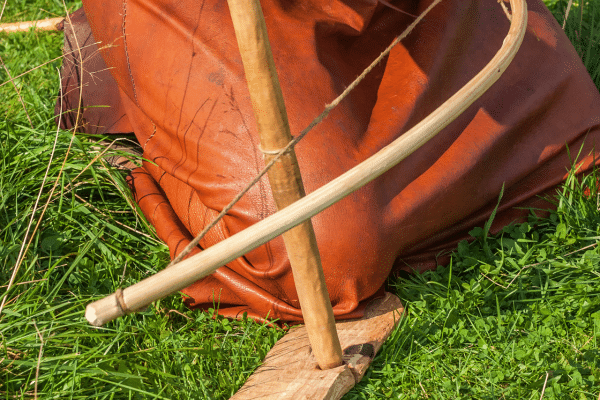
The bow drill method is a sophisticated technique that requires coordination, skill, and practice. It employs a bow to drive a spindle, creating friction against a fireboard to produce heat and ultimately an ember. The setup includes the spindle or drill, a curved bow, a fireboard with a notch for collecting embers, and a handhold or bearing block to apply pressure to the top of the spindle. The bow’s string is wrapped around the spindle, and a sawing motion with the bow spins the spindle rapidly. This action generates friction and heat, creating the ember that is then used to ignite tinder.
Precision in crafting and using the components of the bow drill system is key. The spindle and fireboard must be made of the right type of wood, typically softwood, to ensure enough friction can be generated without excessive effort. Hardwoods, while durable, may not produce the desired results due to the difficulty in generating sufficient friction. The technique of maintaining consistent pressure and speed with the bow is essential for success. The bow drill method is not only a testament to human ingenuity in harnessing natural principles but also a powerful reminder of the skill and patience required to coax fire from wood.
Battery And Foil
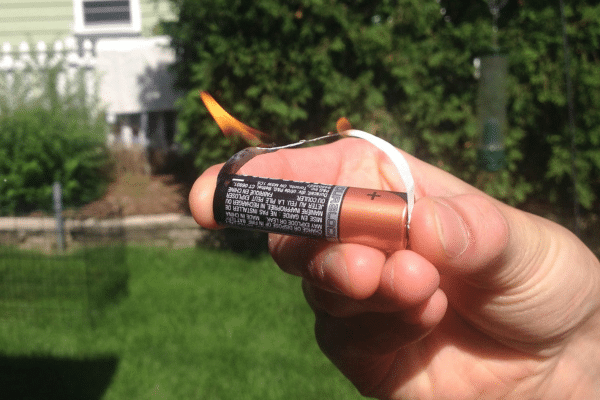
A modern twist on traditional fire-starting methods involves the use of everyday items: a battery and a piece of aluminum foil. This technique capitalizes on the electrical conductivity of the foil and the energy stored within the battery. By creating a conductor bridge between the positive and negative terminals of the battery with foil, the circuit’s resistance causes the foil to heat up rapidly, igniting almost instantly. The foil, often cut or folded into a thin strip to ensure rapid heating, acts as a filament that can set tinder ablaze. This method’s simplicity and the accessibility of materials make it an ingenious solution in situations where traditional tools are not available.
Safety precautions are paramount when employing this method, as the potential for burns or battery damage is significant. The foil should be handled carefully to avoid breaking the delicate strip before it can be used. Additionally, once the fire is ignited, it’s essential to disconnect the foil from the battery immediately to prevent overheating and possible explosion. The choice of tinder is also critical, as the initial flame will be small and short-lived. Materials that catch fire easily and sustain a flame are preferred. This method exemplifies the innovative use of common items in survival situations, offering a quick and efficient way to start a fire.
Ice Lens
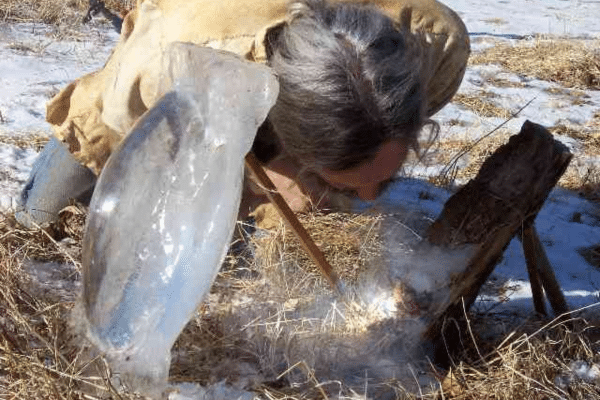
Creating fire with an ice lens is a testament to the ingenuity of survival techniques, turning a seemingly counterintuitive material into a fire-starting tool. This method requires clear ice, which is carved and polished into a lens capable of focusing sunlight onto a small point, much like a magnifying glass. The clarity of the ice is crucial, as impurities can scatter the light, reducing the lens’s effectiveness. The process of shaping the ice into a lens involves melting and polishing, typically with the warmth of hands or a smooth stone. Once formed, the ice lens can concentrate sunlight onto tinder, creating enough heat to ignite it.
The use of an ice lens for starting a fire is particularly suited to cold, snowy environments where other methods may be impractical. It highlights the importance of resourcefulness and the ability to adapt to one’s surroundings. Crafting an ice lens requires patience and a delicate touch, as the ice must be carefully shaped and smoothed without melting it too much. This method not only provides a way to start a fire in challenging conditions but also serves as a reminder of the versatility and unexpected utility found in natural materials. Successfully starting a fire with an ice lens is a remarkable achievement that underscores the balance between knowledge, skill, and the creative application of survival techniques.
The Bottom Line
The ability to start a fire without matches or lighters is a valuable skill, offering independence from modern conveniences and a deeper connection with the natural world. Each method described, from the ancient technique of flint and steel to the innovative use of a battery and foil, showcases human ingenuity and adaptability. These techniques not only serve practical purposes in survival situations but also enrich the outdoor experience, providing a hands-on understanding of the fundamental principles of fire creation. Embracing these methods requires patience, practice, and respect for the elements, reinforcing the importance of preparedness and the joy of mastering traditional skills. As society advances, the knowledge of these time-honored techniques remains a vital link to the past and a testament to the enduring human spirit.


